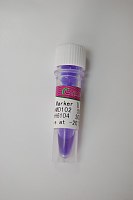Application of FISH to Detect DNA Damage: DNA Breakage Detection-FISH (DBD-FISH)
互联网
724
Chromatin structure can affect the level of induced DNA damage and/or repair, and so these effects may vary within different DNA sequence areas of a cell, as well as between different cell types. DBD-FISH is a procedure that allows both intragenomic and intercellular heterogeneity in DNA breakage induction and repair to be assayed (1 ). Thus, besides whole cellular DNA, the behavior of different specific DNA sequence areas may be simultaneously analyzed within a specific cell. Cells contained within a very thin inert agarose layer on a glass slide are briefly incubated in an alkaline unwinding solution that transforms DNA breaks (2 ,3 ) into single-stranded DNA (ssDNA) motifs. These motifs are initiated from the end of the DNA breaks, serving as targets for hybridization of DNA probes. DNA melting is then stopped and proteins are removed with subsequent incubations in neutralizing and lysing solutions, to yield DNA in a residual nucleus-like structure, known as the nucleoid. After washing and dehydration in increasing ethanol baths, the microgel containing the nucleoids collapses and dries, thereby allowing DNA probes to be hybridized and detected, as in current FISH procedures (4 ). As DNA breaks increase within a specific nuclear target area, the alkali produces more ssDNA in the region and more DNA probe hybridizes, giving rise to a more intense and/or widely distributed FISH signal, which can be captured and quantified with a digital image analysis system. The specific DNA probe determines the chromatin area to be analyzed. In summary, DBD-FISH integrates the microgel techniques habitually employed in the “nuclear halo” (5 ,6 ) or “comet tail” tests (7 ,8 ), the alkaline unwinding assays for the detection of DNA breaks currently used in radiobiological studies (9 ,10 ), and FISH (11 ).



![DBD-NCS [=4-(N,N-二甲基氨磺酰)-7-异硫氰酸基-2,1,3-苯并恶二唑] [用于高效液相色谱标记和埃德曼降解法],147611-81-2,阿拉丁](https://img1.dxycdn.com/p/s14/2024/0619/381/2760431817860733081.jpg!wh200)



